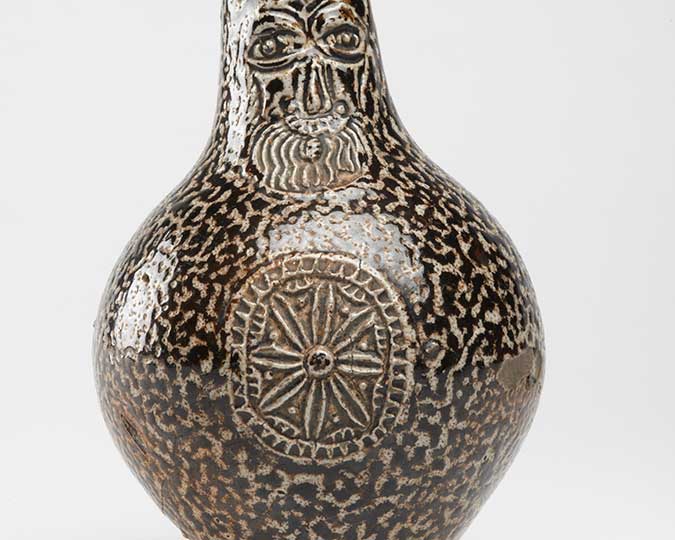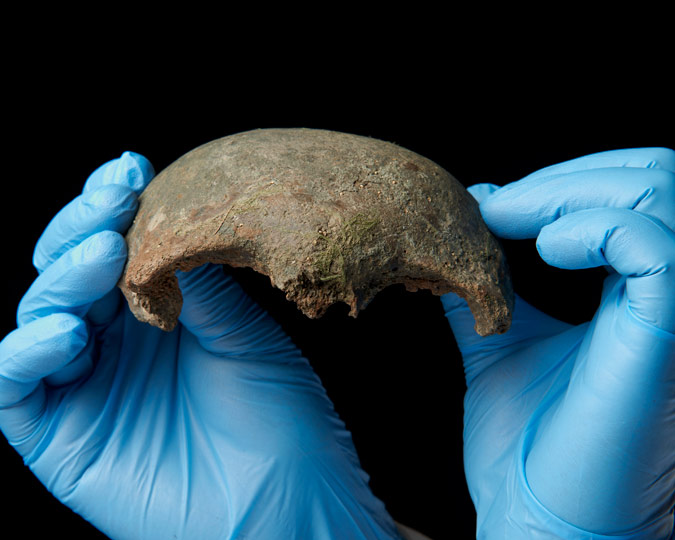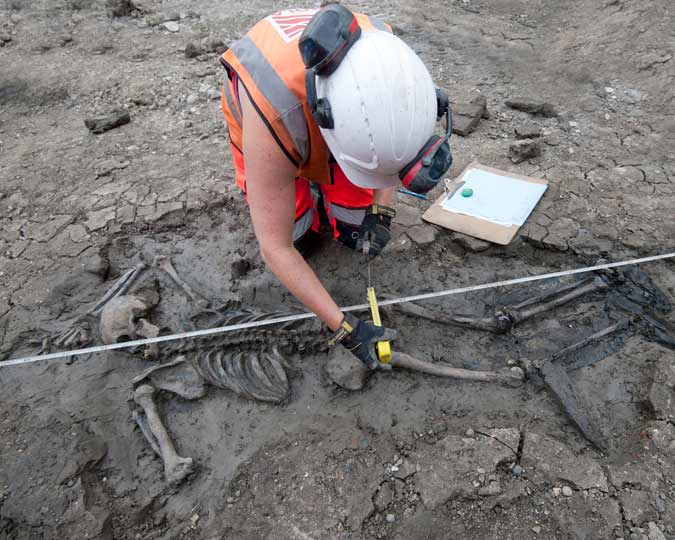How much do we know about the victims of the Black Death pandemic in medieval London? Human Osteology Curator, Rebecca Redfern, explains what skeletal remains from a burial site in East Smithfield can tell us about population diversity in London in the Middle Ages.
The people living in medieval London came to the city from across Britain, Europe, Scandinavia, as well as more distant places such as India. Information about where they came from is recorded in many documents from the time, particularly those about taxes! Many of these documents are available to view and search online and give information on a person’s name, gender, place of origin, nationality, occupation, and where they lived. Like other historical documents, these records tend to provide lots of information about the lives of those with money, power and influence, usually men. This means that the lives of the majority of people, such as the poor, are under-represented, and often not well understood.
At the museum, we want to address these neglected histories, and are trying to get a better understanding about the lives of people who are under-represented in documents made at the time, known as primary sources, by looking to other sources of information. One way of doing this is by studying the skeletons of the people who died here in medieval times. Skeletons contain lots of evidence about a person’s life, which are not always recorded in written records. By looking at traits shared across populations such as the shape of certain bones in the skull and ancient DNA (aDNA) from bones and teeth, we can figure out where people’s ancestors came from. Chemicals in teeth, which are locked-into the hard white enamel, can tell us where they spent their childhoods.
Our recent research project explored the ancestry of Black Death victims in the Middle Ages. We began by looking at the remains of adults who had died during the Black Death pandemic in 1347-1351. This was a plague caused by the Yersina pestis bacteria, which killed many thousands of people across Europe and Asia in the 14th century. Many of the people who died in London were buried at an emergency burial ground at East Smithfield, close to the Tower of London. Written records and archaeological evidence show that it was created before the pandemic reached England, and was only in use for two years, from 1348 to 1350, during the height of the pandemic.
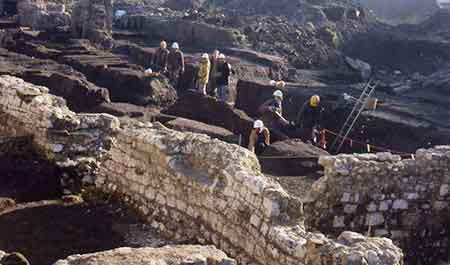
East Smithfield Black Death burial ground
Excavation site, 1980s
In the late 1980s, over 600 skeletons were excavated from the burial ground. Their study has revealed many discoveries about who was at risk of dying from the disease, and also provided the first aDNA proof that the Black Death was caused by the Yersina pestis bacteria. One project looked at the chemicals in teeth, and found that some of the people buried at this cemetery had travelled to London from elsewhere in Britain. This was also confirmed by a larger aDNA study, which examined the mitochondrial DNA (a piece of genetic code passed from mother to child), found in the bones and teeth of many adults from the burial ground.
We could see that these earlier studies only gave part of the picture about the people of medieval London, and we wanted to get more in-depth insight into the diversity of ancestry in the city’s population. To do this, we used a forensic anthropology method called macromorphoscopics, which helps us to establish a person’s ancestry by looking at the shape of their facial bones and other features of their skull. Using data from all over the world, we were able to see which geographical populations the people from East Smithfield were most similar to. The data we used are divided into three broad geographic groupings: Asian, Black African and White European.
Using this method, we studied the skeletons of 41 adults who had died during the Black Death pandemic and been buried at East Smithfield. We discovered that 30% of the skeletons we studied were from people who had Black African ancestry or ancestry that was close to more than one population grouping, suggesting that they had mixed ancestry. This was exciting new evidence that the population of 14th century London during the period of the Black Death was more diverse than has long been thought. Backed up by comparative studies of other cemetery populations, we now think that almost one third of people living in London were of non-White European or mixed ancestral heritage.
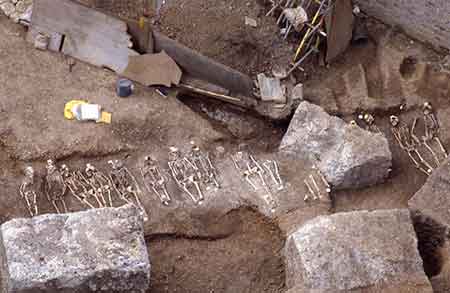
East Smithfield Black Death burial ground
Excavation of one of the mass graves site, 1980s
Remarkably, there were a few people for whom we could uncover further details of their family backgrounds because we also had their chemical and/or aDNA results. In this way, we found that one man with Black African ancestry had spent his earlier childhood in western Britain before travelling to London. We were also able to research a woman with mixed ancestry whose maternal aDNA suggests that her mother’s family was White European from the British Isles. As Osteologists we can glean information about where a person’s ancestors came from, but we cannot deduce what this would have meant for those individuals culturally, in terms of how their ‘race’ was perceived in the society of the time, or how this might have affected their lives.
The medieval researcher, Professor Geraldine Heng, has shed some light on racism in the Medieval Period. Her work shows that people of African origin or descent who had been enslaved in Europe, as well as those who had been freed or were born free, suffered from social, economic and political forms of discrimination. In archaeology, social inequalities can be identified in many different ways, and one way is how people are buried. When we looked at how the skeletons were buried at East Smithfield, we found that none of the plague victims with Black African or mixed ancestry had been maltreated as you might expect to see in a population group that might have suffered from discrimination. We could see that their bodies were placed in the graves with care and respect, as can be seen in the image below. What exactly this might have meant for the status of this population group would require further research and evidence from primary sources.
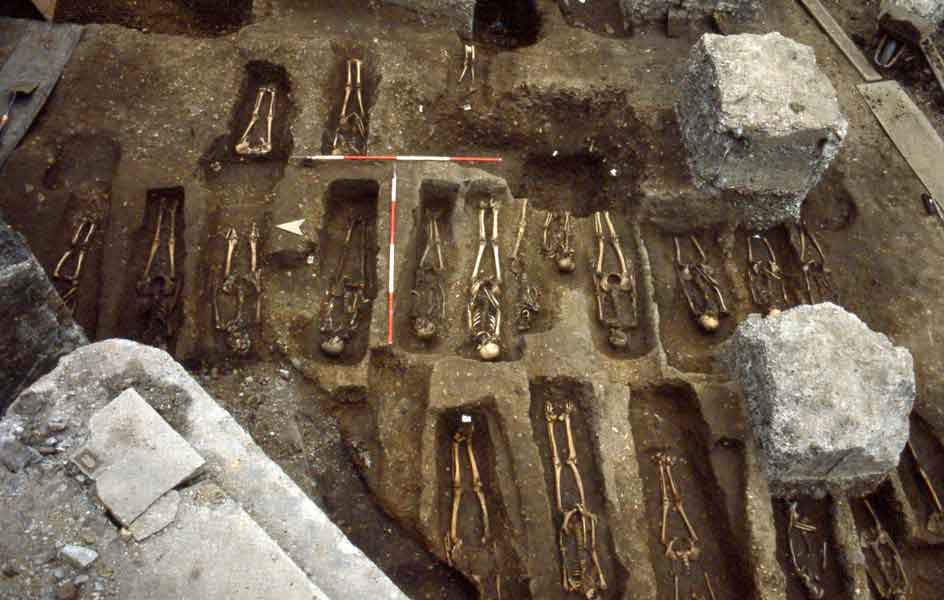
East Smithfield Black Death burial ground, 1980s
The individual graves are shown being excavated by archaeologists.
Trying to get a picture of the people who lived in medieval London means pulling together a wide range of evidence; in this study we’ve shown how research on human skeletons can play a vital part in discovering more about the many people who are missed out of the written records. The next stages of our research involve looking at skeletons from other burial grounds across London, including Spitalfields Market, and early results show that we are finding new evidence for the population of Medieval London being more diverse than the written records suggest.
This piece draws on collaborative work with Dr Joseph Hefner (Michigan State University). Detailed information about the research can be found in this book chapter, and it has also been featured in Bonnie Greer’s ‘In Search of Black History’ podcast. More information about the method used to investigate population diversity can be found on the Macromorphoscopic website (please be aware that this contains images of human remains) and on this webpage from the Smithsonian Institution in Washington DC.








